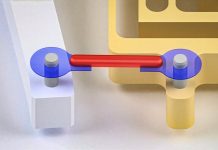
Nature’s smallest creatures often hide the most remarkable secrets.
A team of scientists from the University of California, Berkeley, Georgia Institute of Technology, and Ajou University in South Korea has uncovered one such secret in the Rhagovelia water strider, also called the ripple bug.
These tiny insects are masters at skating across rushing streams, turning sharply, and speeding along the water surface with a precision that rivals flying insects in the air.
The key to their success lies in fan-like structures on their legs.
These fans, which resemble tiny ribbons, can open and close automatically in just 10 milliseconds—ten times faster than a human blink. Unlike muscles, which cost the insect energy to use, the fans morph passively, powered by surface tension and elasticity.
They collapse neatly when not needed, then spring open during propulsion, providing both flexibility and rigidity in one elegant design.
Victor Ortega-Jimenez, an integrative biologist at UC Berkeley, was captivated when he first observed the ripple bugs during the pandemic.
“They moved so fast and turned so sharply, they almost looked like they were flying across the water,” he said. What began as simple curiosity became a five-year collaboration that combined biology, physics, and robotics to reveal how these fans work—and how humans could copy them.
Until this study, published in Science, most researchers believed the fans were powered only by muscles. The discovery that they function passively was a surprise.
When Ortega-Jimenez saw a detached fan expand instantly after touching a droplet of water, he realized nature had engineered a system far more efficient than expected.
This passive action lets the bugs reach speeds of up to 120 body lengths per second and execute hairpin turns in as little as 50 milliseconds.
Inspired by this discovery, the team set out to design a robot that could do the same. Engineers at Ajou University created Rhagobot, an insect-sized robot equipped with artificial ribbon-shaped fans that mimic those of the ripple bug. Early versions modeled after cylindrical hairs failed to deliver the right combination of flexibility and strength.
The breakthrough came when researchers used scanning electron microscopes to reveal the bugs’ true fan structure: flat ribbons. Once this shape was replicated, the robotic fans could self-morph in water without motors or batteries, just as in the real insect.
The result was a tiny robot, weighing only about one milligram, capable of gliding across water with enhanced thrust, braking power, and maneuverability.
The fans give the robot what scientists call “mechanical embedded intelligence”—a form of built-in problem-solving that doesn’t require additional energy or computation. In practice, this means the robot can adapt instantly to its watery environment, much like its living counterpart.
Beyond the engineering triumph, the study revealed that ripple bugs create complex wakes in the water, similar to the vortices produced by flapping wings in flight. This suggests they may even generate lift on the water’s surface, a possibility that could reshape our understanding of insect locomotion.
Living in fast-moving, turbulent streams, ripple bugs endure conditions that would overwhelm most creatures their size. They row across the surface day and night, pausing only to molt, feed, or mate. Their resilience offers lessons for designing robots that can survive in unpredictable environments.
The applications are broad. Bioinspired robots like Rhagobot could one day monitor water quality, assist in search-and-rescue missions, or explore environments too dangerous or inaccessible for larger machines.
By decoding the biomechanics of a rice-sized insect, scientists have not only answered a long-standing mystery in biology but also opened the door to a new class of small, efficient, and adaptable aquatic robots.
As Ortega-Jimenez put it, “It’s as if Rhagovelia have tiny wings attached to their legs, like the Greek god Hermes. Nature has given us a blueprint, and now we can build upon it.”
Source: UC Berkeley.



